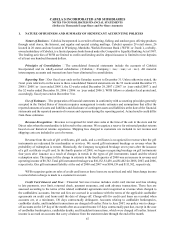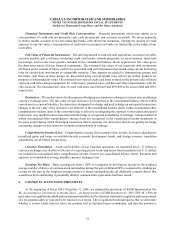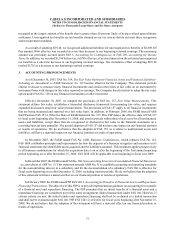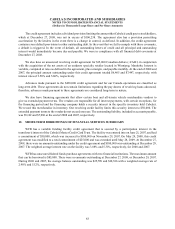Cabela's 2008 Annual Report Download - page 81
Download and view the complete annual report
Please find page 81 of the 2008 Cabela's annual report below. You can navigate through the pages in the report by either clicking on the pages listed below, or by using the keyword search tool below to find specific information within the annual report.76
CABELA’S INCORPORATED AND SUBSIDIARIES
NOTES TO CONSOLIDATED FINANCIAL STATEMENTS
(Dollars in Thousands Except Share and Per Share Amounts)
the excess spread falls below 0%, the receivables that would have been subsequently purchased by the trust from
WFB will instead continue to be recognized on the consolidated balance sheet since the cash flows generated in the
trust would be used to repay principal to investors. Such an event could result in WFB incurring losses related to
its retained interests, including amounts due from trust, investments in asset backed securities, interest-only strip
receivables, cash reserve account, and accrued interest receivable. The investors have no recourse to WFB’s other
assets for failure of debtors to pay other than for breaches of certain customary representations, warranties and
covenants. These representations, warranties, covenants, and the related indemnities, do not protect the trust or the
outside investors against credit-related losses on the loans.
Another feature, which is applicable to the notes issued from Cabela’s Master Credit Card Trust (“CMCCT”), is
one in which excess cash flows generated by the transferred loan receivables are held at the trust for the benefit of the
investors, rather than paid to WFB. This reserve account funding is triggered when CMCCT’s three month average
excess spread rate decreases to below between 4.50% and 5.50% with increasing funding requirements as excess
spread levels decline below preset levels to 0%. Similar to economic early amortization, this feature also is designed
to protect the investors’ interests from loss.
Credit card loans performed within establish guidelines and no other events occurred during 2008, 2007,
and 2006.
In 2003, in connection with the Series 2003-1 securitization, the securitization trust entered into a $300,000
notional swap agreement in order to manage interest rate exposure. The Series 2003-1 swap effectively converted
the interest rate on the investor notes from a floating rate based on a spread over a benchmark to a fixed rate of
3.699%. The Series 2003-1 securitization matured in 2008. In 2008, the securitization trust entered into a $229,900
notional swap agreement in connection with the Series 2008-I securitization in order to manage interest rate
exposure. The exposure is related to changes in cash flows from funding credit card loans, which include a high
percentage of accounts that do not incur monthly finance charges based on floating rate obligations. The Series
2008-I swap effectively converts the interest rate on the investor notes from a floating rate based on a spread over a
benchmark to a fixed rate of 4.32%. Since the trust is not consolidated with WFB, the fair value of the swap is not
reflected on the WFB’s financial statements. Cabela’s entered into a swap with similar terms with the counterparty
whereby the notional amount is zero unless the notional amount of WFB’s swap falls below a required amount,
which effectively makes Cabela’s a guarantor of the swap. The bank pays Cabela’s a fee for the credit enhancement
provided by this swap.
























